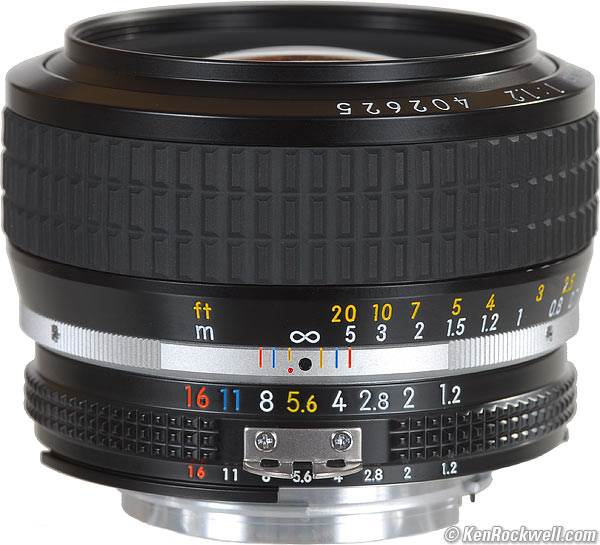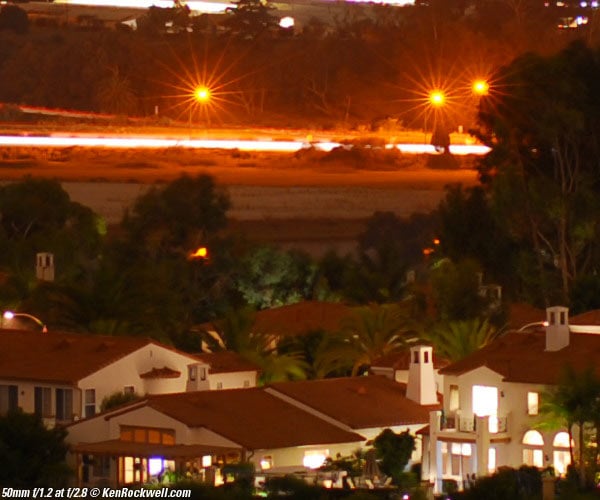Home Donate New Search Gallery Reviews How-To Books Links Workshops About Contact
Nikon
50mm f/1.2
NIKKOR AI and AI-s (1978-today)
© 2007~2012 KenRockwell.com. All rights reserved.
Intro Specs Performance Recommendations
Nikon Nikkor 50mm f/1.2 AI-s (FX, DX and 35mm coverage, 52mm filters, 12.5 oz. /354g, 1.65'/0.5m close-focus, about $650 new or $450 used.). enlarge. My biggest source of support is when you use any of these links, especially these links to them brand-spanking-new at Adorama, B&H Photo-Video and Amazon or this link directly to them at eBay (see How to Win at eBay), when you get anything, regardless of the country in which you live. Thanks! Ken.
December 2012 Nikon Reviews Nikon Lenses All Reviews
Nikon High-Speed 50mm Lens Sharpness Comparison 09 Sep 2010
Nikon 50mm f/1.2 Coma Examples 09 September 2010
Nikon 58mm f/1.2 Noct-NIKKOR review
Introduction top
Intro Specs Performance Recommendations
|
Adorama pays top dollar for your used gear. I use these stores. I can't vouch for ads below.
|
Nikon still does make them like they used to! Not that many Americans buy them, but Nikon still makes manual focus lenses, including this 50mm f/1.2.
This is Nikon's fastest lens currently in production. As a manual focus AI-s lens it works perfectly with every manual focus SLR made since 1959, and also works, with varying degrees of convenience, on all Nikon digital and AF SLRs.
For most people, including myself, I suggest the latest 50mm f/1.4 AF instead for use with modern cameras. The optics are indistinguishable from each other for normal photography, the AF lens is plasticy and made in China, but the ability to autofocus and use all the exposure modes on digital cameras without hassle, as well as a much lower price, make it the obvious choice.
The photographic reason to get a Nikon 50mm f/1.2 is because it's the sharpest Nikon 50mm lens in production when used at f/2. It's only a half-stop faster than f/1.4, so I wouldn't worry about wide-open speed. The f/1.2 performs about the same as the f/1.4 lenses when used at f/1.4, also no big deal.
At f/2, this f/1.2 lens is operating at almost peak sharpness and has no focus shift. The f/1.4 lenses used at f/2 haven't yet reached their peak sharpness, and they oddly also have a slight focus shift which makes them just a little less sharp than this f/1.2 lens when both are used at f/2.
The 50mm f/1.2 is an odd lens that most people forget are still available new, so too many people pay more for them used over eBay and from KEH than I paid for mine brand-new from stock from Adorama.
After throwing so much money at today's plastic (but optically excellent) lenses, it was a real treat to open a brand-new, all metal, engraved markings, made-in-Japan Nikon manual focus lens. There is no lens made today that feels as good. Some people like Leica or the made-in-Japan by Cosina Zeiss-branded lenses, but I find the mechanical precision and focus feel of the Nikon manual focus lenses superior. This Nikkor is a jewel. It's delicate, too, as I cover below.
Compatibility
Like all manual focus AI-s lenses, the Nikon 50mm f/1.2 AI-s works on all Nikon DX and FX digital SLRs, although there's no autofocus and the cheaper DSLRs won't meter with it.
It works flawlessly on the D3.
See Nikon Lens Compatibility for details with your camera. This is an AI-s lens and isoptimal for use on every manual focus film camera.
Use on D40, D40x and D60 etc.
The Nikon D40, D40x and D60 won't autofocus with any Nikon 50mm lens.
The advantage of an AF versus a manual focus lens is that the AF lenses will meter and provide all the exposure modes on these cheapest cameras, while manual lenses requires guessing at exposure.
Any of these lenses can focus manually on these cameras. They also all have an electronic focus confirmation dot which works great.
My D40 seems to provide accurate manual focusing even at f/1.2.
Specifications top
Intro Specs Performance Recommendations
Focal Length
50mm.
On a DX digital SLR it gives an angle of view similar to what a 76mm lens would give on a 35mm film or FX digital camera. See also Crop Factor.
Optics
7 elements in 6 groups.
Traditional spherical design unchanged since 1978.
Diaphragm
9 traditional blades, stopping down to f/16.
I love 9-bladed diaphragms because they give circular out-of-focus highlights and magnificent 18-pointed sunstars. This, and the AI-s 58mm f/1.2 NOCT are Nikon's only fixed 50mm lenses with 9 blades.
The earlier AI (pre AI-s or pre-1981) 50mm f/1.2 AI and 58mm f/1.2 AI Noct only have 7 blades. All other Nikon 50mm, 55mm and 58mm lenses, regardless of age, also only have 7 blades. (Some of the earliest Nikkors only had 6 blades.)
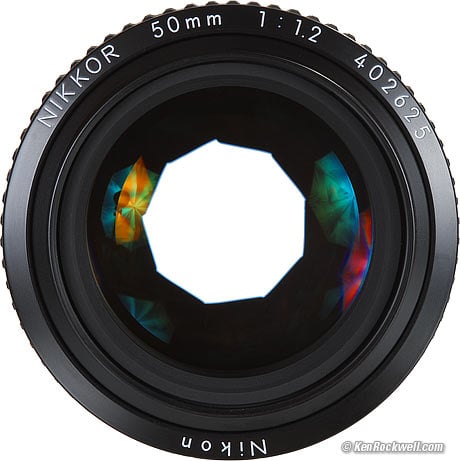
Nikon Nikkor 50mm f/1.2 AI-s diaphragm at f/2.
Filter Thread
52mm, does not rotate.
THis has been Nikon's small-lens standard since 1959.
Close Focus (marked)
1.65' (0.5m).
Maximum Reproduction Ratio
1:7.9.
Focus Scale
Yes, meters and feet.
Depth of Field Scale
Yes, color-coded marks on the chrome grip ring.
Infrared Focus Index?
Yes, the red dot below the line for f/5.6.
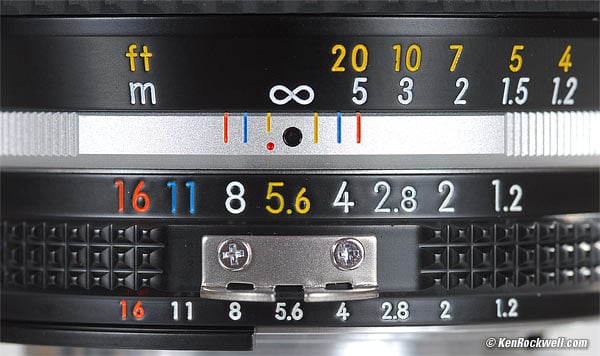
Nikon 50mm f/1.2 depth-of-field scale.
Size
2.687" diameter by 1.861" extension from flange (68.26 x 47.27mm), measured.
Nikon specifies 2.7 x 1.9" (68.5 x 47.5mm).
Weight
12.470 oz. (353.6g), measured.
13.4 oz (380 g) specified by Nikon.
Included Accessories
Excellent pinch-type front cap, dinky translucent rear cap. I replace my rear cap with a real one.
Hood
HR-2 (rubber) or HS-12 (metal), both optional.
Case
CL-34A (per my instruction sheet), CL-31S (per Nikon USA web site), both optional.
Teleconverters
TC-200, TC-201 and TC-14A. Nikon warns that the TC-14A may give some vignetting at close distances.
Nikon Product Number
1435.
Price, Production and History
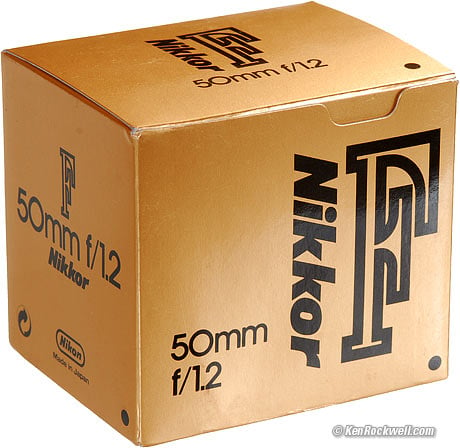
Nikon 50mm f/1.2 Box.
Price, USA
September 2010: $650 at Adorama, $700 at B&H. Nikon's Catalog Price: $725, new, April 2010.
April 2010: $670 at Adorama, $700 at B&H. Nikon's Catalog Price: $725, new, April 2010.
2008: $450 at Adorama (gray market).
2007 October: It was $430, brand-new at Adorama. People who didn't shop well paid about $500 for used ones!
In New York City, the version imported by Nikon USA sold for $400 in 1993 and rose to $550 by 2006.
The 58mm f/1.2 NOCT aspherical sold for $1,200 in NYC in December 1993, but no longer is available new. The 58nm NOCT has always sold, new then or used today, for four figures.
Production
Nikon has made the 50mm f/1.2 AI-s ever since 1981, and still makes them today.
Nikon has made about 150,000 AI-s 50mm f/1.2 lenses so far, which makes it a moderately popular lens.
History
The previous 7-bladed diaphragm AI version was produced from 1978-1981 with presumably the same optics. Nikon made about 75,000 of these.
Nikon made a 55mm f/1.2 from 1966 through 1978 in various AI and non-AI configurations. Nikon made about 175,000 of these.
The presumably superior 58mm f/1.2 NOCT aspherical was made from 1977-1981 as an AI lens, and from 1981 - 1998 as an AI-s. Nikon made about 10,000 of them. The Noct sold for triple the price, which is why people bought fewer of them.
Performance top
Intro Specs Performance Recommendations
The 50mm f/1.2 works better than I had expected. It's super sharp, and distortion is as good or better than the common 50mm f/1.4!
Nikon cautions in the owners manual that if you want good resolution or close-up performance to use the 55mm f/2.8 AI-s Micro instead, however I find this 50mm f/1.2 really good.
This 50mm f/1.2 shines the brightest over other lenses at f/2, since it's working at almost peak performance at f/2, while the f/1.4 and other lenses aren't. Shot at f/1.4 it's about the same as the f/1.4 lenses, and also at f/2.8 and smaller there isn't much difference either.
See also Nikon High-Speed 50mm Lens Sharpness Comparison and Nikon 50mm f/1.2 Coma Examples.
Bokeh performance top
The bokeh is little bit on the bad side of neutral, but still very organic. Their's a pip in middle from point light sources.
Except for use with point sources, the bokeh is quite pleasant. The 9-bladed diaphragm ensures a circular shape.
See Nikon 50mm f/1.2 Coma Examples.
Distortion performance top
Distortion is very slight barrel. It's almost invisible even if you're looking for it, even on film.
The Nikon 50mm f/1.8 and Micro lenses have less (actually no) distortion, if this is critical.
Plug these figures into Photoshop CS2's lens distortion filter to correct the distortion:
On a DX digital camera:
1.5' (0.5m) |
3' (1m) |
7' (2m) |
15' (5m) |
50' (15m) |
Infinity |
+1.6 |
+1.6 |
+1.0 |
+0.5 |
+0.5 |
+0.5 |
© 2007 KenRockwell.com
On film or an FX digital camera:
1.5' (0.5m) |
3' (1m) |
6' (2m) |
15' (4m) |
50' (15m) |
Infinity |
+1.5 |
+2.1 |
© 2007 KenRockwell.com
Ergonomics performance top
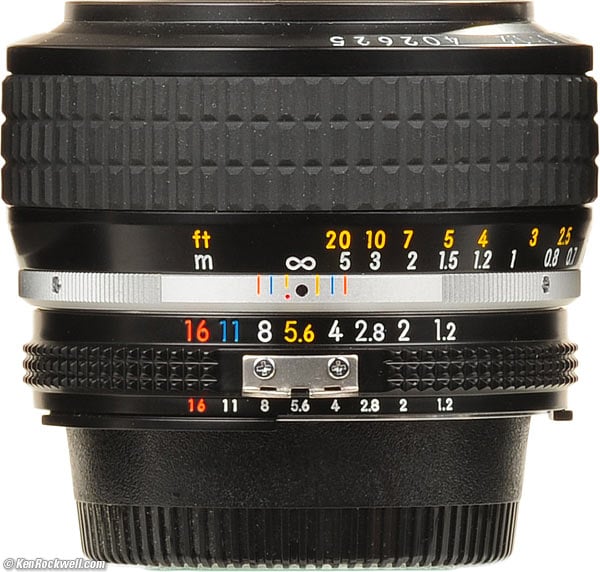
Nikon 50mm f/1.2 AI-s.
Focusing is magnificent. This is one of the reasons I never even considered any other brand in 1983 when I switched to Nikon.
The focus ring is silky-smooth and glides with the touch of just one fingertip. It's somewhat damped, not completely dry like older lenses. The large diameter of the focus ring makes it easy and fast to set precise focus, even at f/1.2.
Focus in today's AI-s version is geared towards faster focus, rather than the more precise gearing of the earlier AI versions.
Like most AI-s lenses, the chrome ring in easy to see and to grab for mounting and unmounting the lens.
Falloff (corner darkening) performance top
No falloff on film at f/2.8. A little at f/2.0.
On a DX digital camera as you can see above at sharpness, falloff isn't an issue.
Flare and Ghosts performance top
Except as above, I see no flare or ghosts in normal use, including when sources of light are in the image.
Focus Screens performance top
What do viewfinder focus screens have to do with the Nikon 50mm f/1.2?
Simple: modern bright screens do not show the limited depth of field at f/1.2. Huh?
In the beginning, focus screens really were made of something similar to ground glass on the Nikon F, F2, F3 and FE cameras up until the 1970s. Back in these days, most people shot with f/2 or faster normal lenses, and f/2.8 wide and tele lenses. The slowest bargain lenses were f/3.5.
Zooms became popular in the 1970s, which started at f/3.5 and got slower from there. Only in the 1990s did f/2.8 zooms become common, and they are still too expensive for most people's budgets today. Today in 2007 most people shoot with f/3.5-5.6 zooms, and pros shoot with f/2.8 zooms. f/2.8 is the fastest lens usually used in 2007.
Therefore SLR cameras have been using very special focus screens, cut by computer-controlled laser with zillions of precise prismatic surfaces instead of just random grain, ever since the 1970s. These special screens optimize brightness with the zoom lenses used by most people, including pros at f/2.8.
Modern focus screens only see through a section of lens up to about f/2.8. They simply don't see any of the light from the outer sections of the lens from faster apertures, so they don't show you the defocus you'll get at f/1.2.
Use the depth of field preview. You won't see any darkening until you get to about f/2.8. In other words, the finder looks as bright at f/2.8 as it does at f/1.2. You're not seeing what you'll get at f/1.2 or f/2!
Still think I'm kidding? Look through the front of the 50mm f/1.2 back into your camera. On a 1980 and newer camera you'll only see light from the screen in the middle of the lens, while on a 1960s camera you'll see the ground glass lit up from the finder's eyepiece throughout the entire open front of the lens.
Do you care? Be forewarned that modern focus screens, meaning all digital cameras and film cameras from the F4 and newer, aren't showing you the full extent of background defocus, nor are they helping you get snap focus on the ground glass.
I don't know of any Nikon focus screens for modern cameras optimized for lenses faster than f/2.8. Canon does. If you care, you may want to shoot an older camera if you use the ground glass to focus or to see depth of field.
The microprisms and split rangefinders of all screens work the same.
Fragility performance top
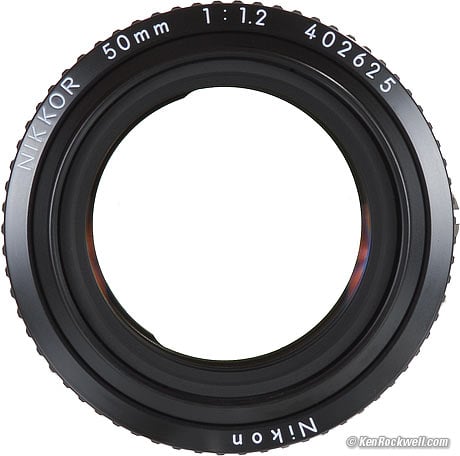
Nikon 50mm f/1.2 at f/1.2
Look through the front of the 50mm f/1.2 at f/1.2. There appears to be nothing inside!
This is an optical illusion: the elements at the front and rear magnify the inner elements. I've read that some people are concerned that the focus helicoids are thinner than other lenses. I don't believe so; the internals are actually much thicker than it appears above, and even if not; the focus ring is much bigger around than the focus ring of the 50mm f/1.4.
There really is a slight cut-out to the rear elements as seen on the left of the image above. The rear element is much larger than slower lenses, and it also pokes further out from the rear of the mount.
Nikon has had to cut some of the rear element away to clear the little finger (as seen on the left below) that couples to the matrix metering system of the F4 and FA. This finger is also a prop to protect the rear element if you set the 50mm f/1.2 down on a table without a cap.
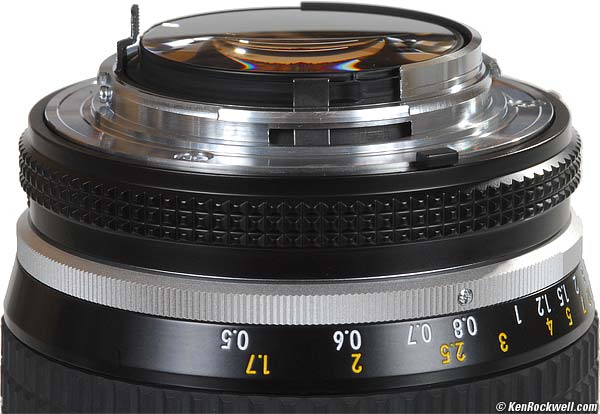
Nikon 50mm f/1.2
See that little pin on the top left? It's just a thin cantilever, not a solid block of metal as on other Nikkor lenses. If you slam the 50mm f/1.2 down on a table, or even if you set it down as you would a drinking glass, you just might bend it.
I am very careful about this. I'm also very careful when mounting my 50mm f/1.2 to a camera, as not to bend this little sliver of metal. On other lenses it's a solid cast lug, but on the 50mm f/1.2 it's merely a vestigial part of the mounting flange.
Be careful.
Lateral Color Fringes performance top
Lateral color is very low. It's better than most zooms. I'd shoot patio furniture with the Nikon 50mm f/1.2 any day.
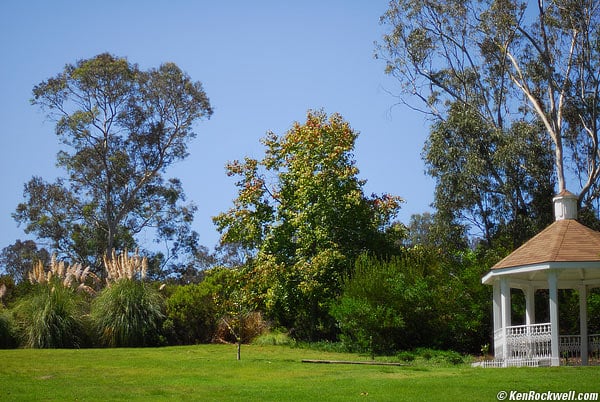
Nikon 50mm f/1.2 at f/1.2, complete image, Nikon D200 (DX).

Nikon 50mm f/1.2 at f/2.8, crop from DX corner at 100%.
You can see more examples on my Nikon 50mm f/1.2 Sharpness page.
Mechanics and Construction performance top
As I've said before and strongly believe, these Nikon AI-s lenses are the pinnacle of mechanical quality.
Exterior
Metal. Black enamel over black anodized aluminum. Cheaper lenses, like the made-in-Japan by Cosina Zeiss-branded lenses, skip the enamel. Oddly, the Zeiss-branded lenses sell for more money and have a much poorer focus feel.
Filter Threads
Metal.
Focus Ring
Rubber-covered metal.
Aperture Ring
Cast metal, engraved and filled markings. Stainless steel aperture coupling flange.
Markings
Engraved and filled with paint.
Switches
None.
Mount
Dull chromed brass.
Internals
Metal.
Noises when shaken
Light clinking, as if there is broken glass floating around. This is normal and actually is the diaphragm blades wiggling around.
Serial Number
Engraved and filled with white paint on the front of the focus ring.
Made in
Japan.
Sharpness (click for new page of detailed examples) top
I have a separate Nikon 50mm f/1.2 Sharpness page which is as big as this page. I had to split it off because the software with which I write this website couldn't handle a combined page that big.
I also have explicit comparisons to the 50mm f/1.4 AI, and a Nikon High-Speed 50mm Lens Sharpness Comparison.
On Fuji Velvia 50 film, it's sharp but hazy (lower contrast) at f/1.2. It's super-sharp in daylight stopped down, and it's also super sharp and contrast from f/2.
Sunstars performance top
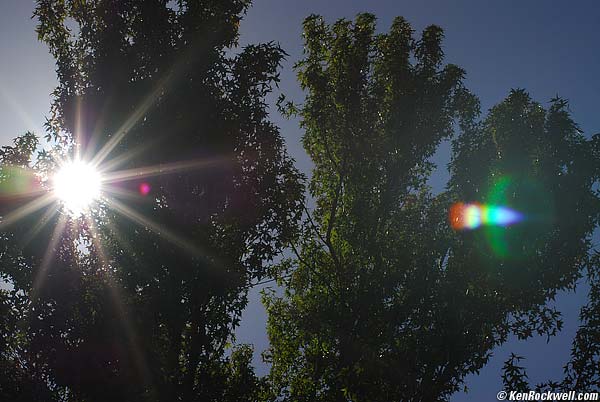
Nikon 50mm f/1.2 sunstars
The 9-bladed diaphragm gives rise to extraordinary 18-pointed stars on brilliant points of light.
They are hard to create in daytime, since you're asking for trouble if you point an f/1.2 lens at the sun. You'll go blind and destroy your camera. These stars become more prevalent at smaller apertures, but the 50mm f/1.2 only stops down to f/16.
Here's a pair of crops from 100% images from my D200. (The full images are on my 50mm f/1.2 Sharpness page)
Star comparison at f/2.8. (mouse-over to compare to the 50mm f/1.4 AI)
I love the 18-point stars from the 9-bladed diaphragm. The f/1.4 lenses and earlier AI versions of the this f/1.2 and the AI Noct f/1.2 lenses only have seven-bladed diaphragms. The only other 9-bladed 58mm from Nikon is the 58mm Noct AI-s.
I'd take even the 14-pointed star from other 7-blade lenses over the bogus 8-pointed stars of most of Canon's lenses any day (or night).
These stars are how we tell if a shot was made with Canon or Nikon. You'll see them all the time from reflections of cars in car magazines.
Recommendations top
Intro Specs Performance Recommendations
For most people, especially with digital cameras, the Chinese-made 50mm f/1.4 AF-D is a much more practical choice, and it costs less.
This 50mm f/1.2 ia a special interest manual-focus lens. Get it only if:
1.) You want the best manual-focus 50mm still made today. The 50mm f/1.2 has the same or better performance than the 50mm f/1.4 AI-s, and the 50mm f/1.8 manual focus lens is no longer made. I prefer the performance of this 50mm f/1.2 in many ways over the 50mm f/1.4 Zeiss-branded, Cosina-made lens.
2.) You want the sharpest 50mm lens still made today by Nikon to shoot specifically at f/2.
3.) You have a thing for 9-bladed diaphragms as I do.
4.) You enjoy the feel of a first-class mechanical masterpiece.
5.) You'd like to get a collectible lens while you still can, brand-new.
6.) You might even be able to sell it next week for more money, but don't bank on it now that I've let the cat out of the bag.
For real photography of living, moving things, the Nikon 50mm f/1.4 AF is more practical, presuming you're using an autofocus or digital camera. This manual focus lens won't autofocus.
On cheaper digital SLRs and cheaper AF film cameras, the Nikon 50mm f/1.2 won't even meter (see Nikon Lens Compatibility).
If you want the sharpest possible 50mm lens to shoot at f/1.2 for astronomy, get the Canon 50mm f/1.2 L aspherical, which is a brand-new aspherical autofocus design and sells for a fraction of the price of an old used 58mm f/1.2 NOCT.
If you want the highest possible performance at f/1.2 on Nikon, look for the 58mm f/1.2 NOCT. For the price of a used NOCT alone, you can buy the newer Canon autofocus Canon 50mm f/1.2 L aspherical and a Canon 5D body, or all the Canon EOS film bodies you can carry.
If you want the best possible optical quality at reasonable apertures in daylight or on a tripod, use any of the f/1.8 lenses. Sharpness is the same, but the f/1.8 lenses have no distortion while the faster lenses have some.
Nikon makes no super-speed 50mm autofocus lenses. We're still waiting. This 50mm f/1.2 lens is nice, but it's a 1978 design which Canon has far exceeded.
Hobbyists like the idea of a new 50mm f/1.2 AF-S, however with the great high ISO performance of digital as compared to film, lenses faster than f/2.8 aren't really needed anymore.
The fastest decent color film available when this version of this f/1.2 lens was designed (1978) was ISO 64 Kodachrome. Fast lenses were needed for available-light news shooting. Kodachrome 200 didn't arrive until 1986, and newsmen didn't start shooting ISO 400 color negative film until the 1990s. That's why the 28mm f/1.4 AF, introduced in 1993, sort of missed its boat and never sold well to professionals (or anyone).
With the crappiest Nikon D40 giving relatively stellar results compared to film at ISO 1,600, I do just fine today with an f/3.5-5.6 zoom.
I have no idea if a 50mm f/1.2 AF-S lens is in Nikon's near future. With the D3 perfectly happy to shoot at ISO 6,400, I'd put a 50mm f/1.2 AF-S more in the "crazy Nikon products" boat, like the modern S3 and SP rangefinder re-issues, more so than something I'd expect mainstream. Newsmen far prefer the 24-70mm f/2.8 zoom at ISO 6,400 over a fixed, faster lens at a slower ISO.
For shooting still subjects hand-held in the lowest light, I prefer a shorter lens like the 28mm f/1.4 AF because the shorter focal length gives me another stop before I get blur, and far deeper depth of field.
More Information:
Nikon Japan's product data (in English)
Some unknown person (to me, anyway), with data from unknown sources and who spells even more poorly than I do, plotted graphs of supposed performance of similar lenses here. If you believe this (I don't see enough substantiation to take it seriously), it shows that this 50mm f/1.2 is much better than even the NOCT most of the time where it matters.
Help me help you top
I support my growing family through this website, as crazy as it might seem.
The biggest help is when you use any of these links when you get anything, regardless of the country in which you live. It costs you nothing, and is this site's, and thus my family's, biggest source of support. These places have the best prices and service, which is why I've used them since before this website existed. I recommend them all personally.
If you find this page as helpful as a book you might have had to buy or a workshop you may have had to take, feel free to help me continue helping everyone.
If you've gotten your gear through one of my links or helped otherwise, you're family. It's great people like you who allow me to keep adding to this site full-time. Thanks!
If you haven't helped yet, please do, and consider helping me with a gift of $5.00.
As this page is copyrighted and formally registered, it is unlawful to make copies, especially in the form of printouts for personal use. If you wish to make a printout for personal use, you are granted one-time permission only if you PayPal me $5.00 per printout or part thereof. Thank you!
Thanks for reading!
Mr. & Mrs. Ken Rockwell, Ryan and Katie.
Home Donate New Search Gallery Reviews How-To Books Links Workshops About Contact

